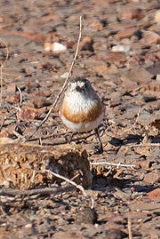
Chestnut-breasted Whiteface
Encyclopedia
The Chestnut-breasted Whiteface (Aphelocephala pectoralis) is a species of bird
in the Pardalotidae family.
It is endemic to Australia
and found primarily in northern South Australia
.
in the North West region of the state is a stronghold for the species and has been classified as an Important Bird Area
.
mining. There has been a large increase in mining activity in South Australia in recent years, some of which is known to have directly impacted areas that have supported relatively high densities of the species
Bird
Birds are feathered, winged, bipedal, endothermic , egg-laying, vertebrate animals. Around 10,000 living species and 188 families makes them the most speciose class of tetrapod vertebrates. They inhabit ecosystems across the globe, from the Arctic to the Antarctic. Extant birds range in size from...
in the Pardalotidae family.
It is endemic to Australia
Australia
Australia , officially the Commonwealth of Australia, is a country in the Southern Hemisphere comprising the mainland of the Australian continent, the island of Tasmania, and numerous smaller islands in the Indian and Pacific Oceans. It is the world's sixth-largest country by total area...
and found primarily in northern South Australia
South Australia
South Australia is a state of Australia in the southern central part of the country. It covers some of the most arid parts of the continent; with a total land area of , it is the fourth largest of Australia's six states and two territories.South Australia shares borders with all of the mainland...
.
Habitat
The species's preferred habitat is open terrain in hilly areas such as tablelands, with a stony landscape and a patchy cover of perennial chenopod shrubs. The species is most frequently seen in areas where the topographic relief gives rise to creek lines, in which there tends to be denser shrubby vegetation. It feeds on the ground and takes seeds and arthropods. It is threatened by habitat loss. Bulgunnia StationBulgunnia Station
Bulgunnia Station is a 18,500 km2 sheep station in north-western South Australia. It lies 75 km south-west of Coober Pedy and about 750 km north-west of the state capital, Adelaide. It carries 26,000 merinos and is operated with a staff of seven people. It is one of four adjoining...
in the North West region of the state is a stronghold for the species and has been classified as an Important Bird Area
Important Bird Area
An Important Bird Area is an area recognized as being globally important habitat for the conservation of bird populations. Currently there are about 10,000 IBAs worldwide. The program was developed and sites are identified by BirdLife International...
.
Threats
Grazing by livestock and rabbits is the primary long-term threat as it reduces the recruitment of perennial shrubs, particularly low bluebush Maireana astrotricha, upon which the species depends. Heavy grazing of the chenopod shrubland has almost certainly caused the species to vacate previously used sites. Ironically, a recent reduction in rabbit numbers may have allowed a sufficient build up of fuel for fire to be a threat, particularly if occurring over a large area simultaneously. Some patches of habitat are threatened by opalOpal
Opal is an amorphous form of silica related to quartz, a mineraloid form, not a mineral. 3% to 21% of the total weight is water, but the content is usually between 6% to 10%. It is deposited at a relatively low temperature and may occur in the fissures of almost any kind of rock, being most...
mining. There has been a large increase in mining activity in South Australia in recent years, some of which is known to have directly impacted areas that have supported relatively high densities of the species

